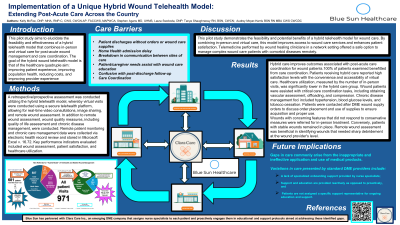Practice Innovations
(PI-042) Implementation of a Unique Hybrid Wound Telehealth Model: Extending Post-acute Care Across the Country
Friday, May 2, 2025
7:45 PM - 8:45 PM East Coast USA Time

Cheryl Carver, LPN; MyerAnn Mangalino, DNP; Kristen Elizabeth Hameline, BSN; Kelly McFee, DNP; Jacqueline Mongusu, MSN; Audrey MoyerHarris, BSN; Erica Robinson, LPN; Yisel Ruiz, MSN; Tanya Shaughnessy, BSN; Monica Trujillo, BSN
Introduction: This pilot study aims to elucidate the feasibility and effectiveness of a hybrid telehealth model that combines in-person and virtual care for post-acute wound management and care coordination. The goal of the hybrid wound telehealth model is that of the healthcare quadruple aim: improving patient experience, improving population health, reducing costs, and improving provider experience.
Methods: A retrospective/prospective assessment was conducted utilizing the hybrid telehealth model, whereby virtual visits were conducted using a secure telehealth platform, allowing for real-time video consultations, image sharing, and remote wound assessment. Wound healing trending was performed in eKare. In addition to remote wound assessment, wound quality measures, including quality of life assessment and chronic disease management, were conducted. Remote patient monitoring and chronic care management data was collected via electronic health record review and stored in Microsoft Excel v. 16.72. Key performance indicators evaluated included wound assessment, patient satisfaction, and healthcare utilization.
Results: Hybrid care improves outcomes associated with post-acute care coordination for wound patients. 100% of patients examined benefitted from care coordination. Patients receiving hybrid care reported high levels of satisfaction with the convenience and accessibility of virtual care. Healthcare utilization, measured by the number of in-person visits, was significantly lower in the hybrid care group.
Wound patients were assisted with critical care coordination tasks, including obtaining vascular assessment, offloading, and compression. Chronic disease management foci included hypertension, blood glucose levels, and tobacco cessation. Patients were contacted after DME wound supply orders to discuss order placement and use of supplies to ensure acquisition and proper use.
Wounds with concerning features not responding to conservative measures were referred for in-person treatment. Conversely, patients with stable wounds remained in place. Remote wound assessment was beneficial in identifying wounds that needed sharp debridement at the wound provider's level.
Discussion: This pilot study demonstrates a hybrid telehealth model's feasibility and potential benefits for wound care. By combining in-person and virtual care, this model improves access to wound care services and enhance patient satisfaction. Telemedicine performed by wound healing clinicians working in a network setting offered a safe option to remotely manage complex wound care patients with comorbid diseases.
Methods: A retrospective/prospective assessment was conducted utilizing the hybrid telehealth model, whereby virtual visits were conducted using a secure telehealth platform, allowing for real-time video consultations, image sharing, and remote wound assessment. Wound healing trending was performed in eKare. In addition to remote wound assessment, wound quality measures, including quality of life assessment and chronic disease management, were conducted. Remote patient monitoring and chronic care management data was collected via electronic health record review and stored in Microsoft Excel v. 16.72. Key performance indicators evaluated included wound assessment, patient satisfaction, and healthcare utilization.
Results: Hybrid care improves outcomes associated with post-acute care coordination for wound patients. 100% of patients examined benefitted from care coordination. Patients receiving hybrid care reported high levels of satisfaction with the convenience and accessibility of virtual care. Healthcare utilization, measured by the number of in-person visits, was significantly lower in the hybrid care group.
Wound patients were assisted with critical care coordination tasks, including obtaining vascular assessment, offloading, and compression. Chronic disease management foci included hypertension, blood glucose levels, and tobacco cessation. Patients were contacted after DME wound supply orders to discuss order placement and use of supplies to ensure acquisition and proper use.
Wounds with concerning features not responding to conservative measures were referred for in-person treatment. Conversely, patients with stable wounds remained in place. Remote wound assessment was beneficial in identifying wounds that needed sharp debridement at the wound provider's level.
Discussion: This pilot study demonstrates a hybrid telehealth model's feasibility and potential benefits for wound care. By combining in-person and virtual care, this model improves access to wound care services and enhance patient satisfaction. Telemedicine performed by wound healing clinicians working in a network setting offered a safe option to remotely manage complex wound care patients with comorbid diseases.

.jpg)